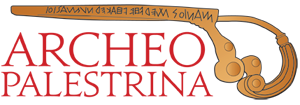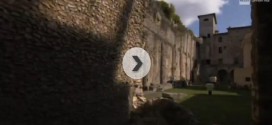The discovery of Prenestine archaeology
The ancient monuments of Palestrina, and in particular the grandiose sanctuary, were known as early as the 16th and 17th centuries, as evidenced by plans, views, and reconstructive drawings by Andrea Palladio (1550), Federico Cesi (1614) and later Suares (1655), and Pietro da Cortona (c. 1650), followed by many others until the 1800s, particularly by Grand Tour travelers and boarders from the French Academy.
The excavations of the 18th and 19th centuries: the gold rush
But the real start of the discovery of Praeneste’s archaeological riches was the discovery in 1738 of the cista, called Ficoroni after its discoverer Francesco Ficoroni. The intricacy of its decoration and the inscription commemorating the craftsman and the recipient, but also the place where it was produced, Rome, aroused such interest that from then on continuous excavations were initiated in the city’s necropolis throughout the 18th and 19th centuries, the work more of looters than of scientists, who sought only valuable objects to fuel collecting and a flourishing market. These activities continued intensely despite the cultural heritage protection regulations in place in Italy as early as the early 19th century and caused Palestrina’s archaeological heritage to be dispersed throughout Europe and beyond.
Gold Cup London, Victoria and Albert Museum
The discovery of the princely tombs
The grave goods from the Castellani and Galeassi tombs, which came to light in 1861-62, were dismembered and largely dispersed, except for a core of the former that was donated to the Capitoline museums, and the rich gold and silver ornaments of the latter that passed to the British Museum. Of other princely tombs, only clues and sporadic objects remain, such as the gold cup currently in the Victoria and Albert Museum in London.
The Museum of the Archaeological Association and the Barberini collection.
After much looting in the early 1900s an awareness of the local ownership of such treasures began to awaken.
The Museum of the Archaeological Association
In 1905 the Prenestina Archaeological Association was formed in Palestrina with the aim of preserving monuments and establishing a city museum. The Association began an intense excavation activity, both in the urban area and in the necropolis, and the artifacts collected went on to form the first nucleus of a museum.
The Barberini collection
At the same time, the Barberini family had also begun to conserve the artifacts found on its Prenestine properties, although not distinguished by individual grave goods. As early as 1908 part of the Barberini collection was sold to the state, which assigned it to the Villa Giulia Museum, where it was displayed in 1913. A small part of this collection later returned to the Palestrina Museum.
In that same year Luigi Barberini, a lover of antiquities, decided to restore the baronial palace, built on the ruins of the summit part of the sanctuary of Fortuna, to house that part of the collections that remained in the family’s possession: the Museo Prenestino Barberiniano was born, where the famous mosaic of the Nile was also kept.
The war, the rediscovery of the Fortuna shrine and the establishment of the National Museum
The bombings of 1944
During World War II, the Soprintendenza decided to concentrate the most important works of art in Rome for greater security. Among these, the Nile mosaic of Palestrina was moved to the Museo Nazionale Romano. The operation was most opportune, since Palestrina suffered two bombings, one on January 22, 1944, and another, more devastating, on June 1 of the same year, which almost completely destroyed the upper part of the city and did serious damage to the baronial palace.
The rediscovery of Fortuna’s shrine and the establishment of the Museum
Following these bombings, the removal of the rubble made it possible to unearth the grandiose remains of the Fortuna sanctuary. It was a historic feat, implemented in a few years by architect Furio Fasolo and archaeologist Giorgio Gullini. From a pile of rubble re-emerged one of the most impressive monuments of Hellenistic architecture in Italy. The redevelopment of the temple complex, which lasted from 1945 to 1952, also resulted in the state’s acquisition of the Palazzo Colonna Barberini and the properties below to create a new national museum and make the archaeological complex visitable. The museum was inaugurated in 1956 in the presence of then-President of the Republic Giovanni Gronchi, an event that had wide resonance abroad as well.
The new exhibit in 1998
After the National Archaeological Museum of Palestrina opened to the public in 1956, many new discoveries followed.
One of the most important sites excavated in the 1980s was the sanctuary dedicated to Hercules, located southwest of the city, which yielded thousands of votive offerings datable between the 6th century B.C. and the early imperial age. Other hugely important discoveries have concerned the urban area, where finds of the highest quality have come to light, such as for example the relief with a wild boar from the “Grimani” series.
These numerous and very important new acquisitions have gradually expanded the original nucleus to form a remarkable collection that has necessitated a complete overhaul of the museum and its total new layout, designed by architect Maurizio Brufatto, in larger forms appropriate to the modern principles of museology.
The reorganization of the exhibition was inspired by a partly thematic, partly chronological criterion, taking into account the contexts of origin of the artifacts. It was also designed with full respect for the “container,” the Palazzo Colonna Barberini, an admirable example of a perfect architectural combination of archaeological pre-existence and Renaissance design.
The 2014 renovation of the museum’s layout.
Today the museum presents itself to visitors in a renewed and even richer guise.
The inexhaustible subsoil of Palestrina has continued in recent years to return fragments of the history of the ancient Latin and then Roman center, and all these new scientific acquisitions are now offered to the visitor, included in the already structured tour route.
In addition, the exhibition itinerary has been enriched with important finds from the Praeneste necropolis, returned to Palestrina from the National Etruscan Museum of Villa Giulia in Rome.
The most recent excavations
The oldest city, the one enclosed in the walls that today corresponds to the historic center, has been the subject of systematic investigations, especially in the area of the ancient Forum; in the so-called “lower city,” which since the Middle and Late Republican period expanded on the plateau below the oldest settlement, sectors of the settlement with public and private buildings have been brought to light, as well as places of worship active since the Late Archaic period, whose life continued for several centuries until the threshold of the empire. The most prolific area for new discoveries was the necropolis, where excavations uncovered many new burials dating from the 8th to 3rd centuries BCE.
 Archeopalestrina Percorso archeologico di Palestrina, l'antica Praeneste
Archeopalestrina Percorso archeologico di Palestrina, l'antica Praeneste
